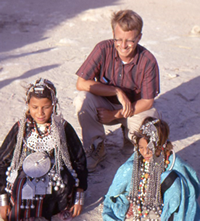Welcome to the Nutritional Geography website. This website provides research-based content created by Dr. Louis E. Grivetti, Professor Emeritus at the University of California, Davis Nutrition Department.
Nutritional geographers conduct their research within the construct of three sub-fields:cultural, economic, and physical geography. Nutritional geography lies at the junction or interface of the three sub-fields:
- cultural – religion and family history influence food practices and nutritional status
- economics – poverty vs. affluence determines access to food availability and relative food costs)
- physical – the environment presents opportunities for different types of food-related activities from hunting-gathering, pastoralism, agriculture, horticulture, and urban lifestyles.
Nutritional geography, therefore, may be seen as interconnected and integrated with the three sub-fields that comprise basic geographic studies. Nutritional geography may be perceived as a narrow or broad field.
If narrowly defined, the research topics still must integrate the two distinct components: geography and nutrition science. Such topics could include cultural, economic, and environmental factors that influence the presence/absence of deficiency diseases, famine, malnutrition, and other nutrition- or physiological-related problems. Such topics can be set within geographical concepts of aerial distribution, mapping spatial patterns, and how practices or nutritional change through time.
If broadly defined, nutritional geography expands to include information from other fields and can incorporate topics within the fields of agriculture, anthropology, botany, history, and sociology. Projects may include: access to food, food distribution, and a host of human, cultural practices that effect how, when, and why foods are selected or rejected, and the ultimate nutritional consequences of human food-related behavior – whether from historical or contemporary perspectives.
